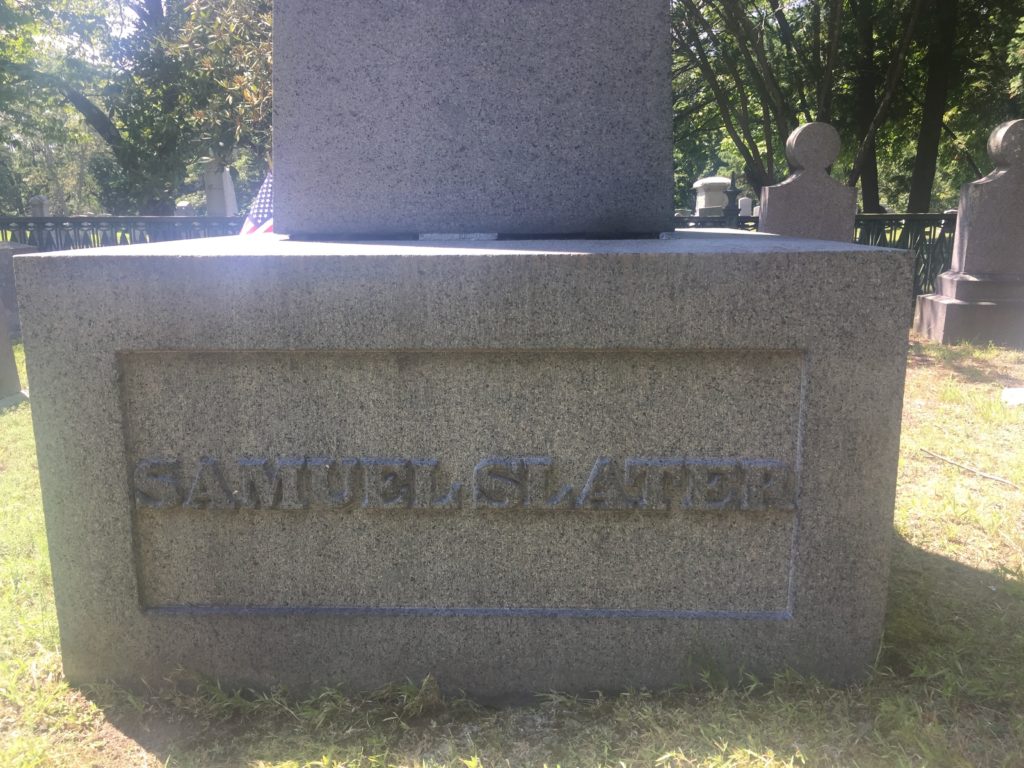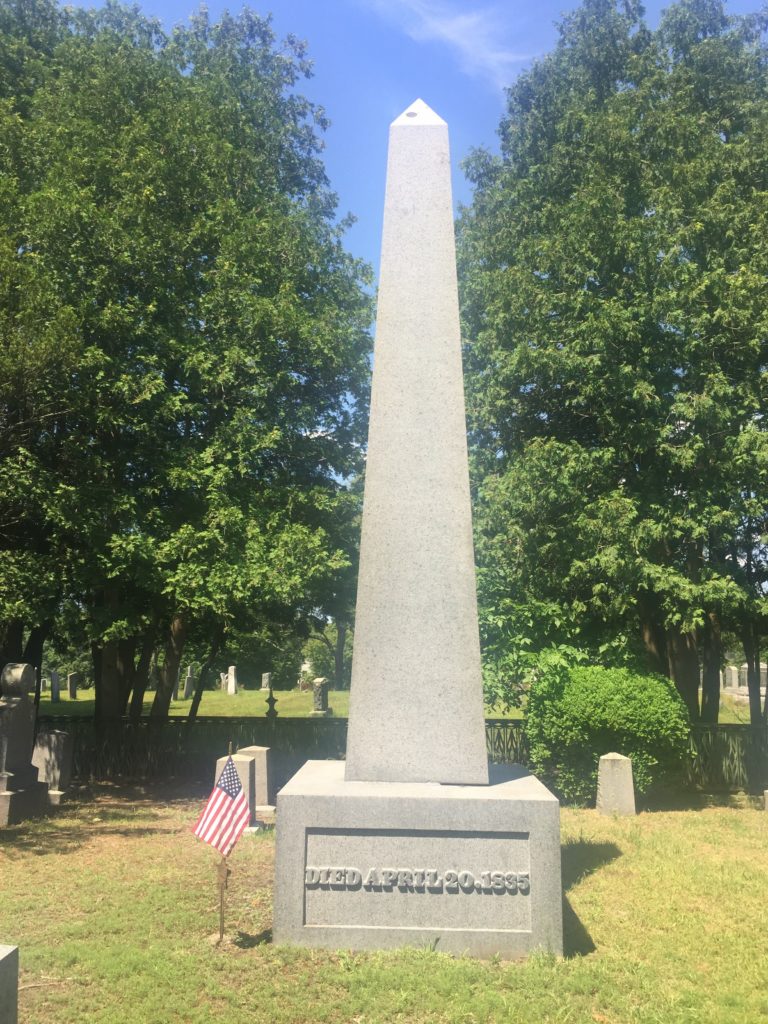Erik Visits an American Grave, Part 743
This is the grave of Samuel Slater.


Born in 1768 in Derbyshire, England, Slater went into the new industrial mills of his region of the nation as a young child. He was working in the textile mills by the time he was 10 years ago, after a very basic education. This would become an increasingly common route for young children in England and, in large part because of Slater, in the United States as well. In 1782, Slater’s father, a fairly well off yeoman farmer, died and so his mother indentured him as an apprentice to Jedediah Strutt, who was one of the pioneers of modern mills. Slater was a very smart kid and Strutt could see that, so Slater became his top assistant. Strutt’s partner was Richard Arkwright, who had built the world’s first cotton-spinning mill in 1768. So Slater was working at the forefront of this young industry.
Now, the British knew they had a huge technological advantage over other nations with their modern mills. So they tried to keep that advantage. The government refused to allow those with knowledge of the mills’ technology to even travel to other countries and worked very hard to ensure no plans could get out either. But this was a fool’s game. There was no way they could keep the technology under wraps and the government was too rudimentary to really stop everyone who knew anything about it from traveling. Slater was an ambitious young man. He had also a great memory. So he was able to sneak out of Britain, without any plans, but with full knowledge in his head of how to build a mill. He came to the United States in 1789. This helped blow up the monopoly the British had. In fact, as he established modern factories in the United States, he became known as “Slater the Traitor” back home.
Slater chose to move to the U.S. because he believed that the British were flooded with mills and he could not make his fortune there. But in the U.S., the opportunities were endless. Americans were desperate to get out from under the thumb of the British economy. The British had ensured that factories had to be built at home rather than the colonies by the 1750s and so even after independence, the U.S. was dependent on European economies for manufactured goods. This was not an acceptable situation for the nationalistic young nation. Slater went far to end this problem.
Well, Slater didn’t mind being a called a traitor much because he would get quite rich. Slater first went to New York City, but didn’t see much interest to build a factory there. It wasn’t the most sensible spot anyway because it did not have the waterfalls necessary to power the machines. He did work briefly for a concern in New York attempting to build a factory there, but left when he saw it was hopeless. But southern New England had a lot of these little waterfalls to run the spinning wheels, and very near the ocean too. In 1789, Moses Brown built what was the first real industrial factory in the U.S. in Pawtucket, Rhode Island. The location was great. But the factory was poorly designed. Brown simply didn’t understand the mill system well enough. Slater found out about this and offered his services to Brown, telling him that if the factory didn’t work, he would take no money. Brown agreed, writing back to Slater:
We are destitute of a person acquainted with water frame spinning. … If thy present situation does not come up to what thou wishest… come and work [with] ours and have the credit as well as the advantage of perfecting the first watermill in America.
By 1791, Slater had the factory up and running. It was rudimentary. But by 1793, a full-fledged factory in Pawtucket was in full operation. It was a huge success. It’s also a cool museum to visit, when such things are possible. I highly recommend it as one of the best history sites in the state, more interesting than the boring Newport mansions, in my opinion.
Slater had of course been a child laborer. And so that’s who he recruited to work in his factories. Children as young as 7 (!) became his workforce. Now, given the role of New England family structures, that wasn’t quite going to work because children were unlikely to travel far away from their parents, who wouldn’t allow that. So while child labor would long remain a key part of the textile labor system, and remains so today as the industry constantly leads the way in seeking the most exploitable labor in the world, this would transition into the development of the mill village, with women, children, and even some men working in the factories. That New England was already losing population because of its terrible soil was an advantage as well. If you weren’t moving to western New York or other places were fewer rocks in the soil, you might quite likely find the factories a more palatable option than scraping away at what good farmland there was after 150 years on already bad land.
Supposedly, Slater was a “good employer” to these children, giving them the chance to go to Sunday School, and feeding them decently and such. But this to me sounds like the inevitable “humane owner” bit that one gets when going on plantation tours in the South. Thus began the company town in the United States. He founded Slatersville, Rhode Island in 1803, a full-fledged mill village with the most recent technology in the mill, tenement-style housing for workers, and a company store. The became known as the Rhode Island System.
Slater’s innovations combined with Eli Whitney’s cotton gin to transform labor in the United States, north and south. And it made Slater a very wealthy man. He split from Brown in 1798 and soon opened new factories across southern New England. Other investors joined him and often improved on his work to make their own fortunes. The Industrial Revolution of the United States had begun. Slater’s brother came over in 1799. He had learned the most recent innovations from England and he applied them to Slater’s new mill. By 1815, there were 140 mills within 30 miles of Providence, many of them founded since Jefferson’s Embargo, as the nation needed to ramp up production without imports coming into the nation. The War of 1812 sped this up even more. In those 140 mills were 26,000 workers. The area would remain the center of American textile production for a nearly a century.
Now, Slater was an important figure, but in the end he wasn’t the best or most modern businessman. As he aged, he became increasingly inflexible and this threatened his mini-empire that included mills in Rhode Island, Connecticut, and Massachusetts. He constantly hired family members to run the factories, which had its limitations. He invested in new factories to make the manufacturing machinery itself. But he had trouble managing all his different interests. It took his son taking over the empire in 1829 to reorganize everything and bring new innovations into management. Labor conditions also remained terrible at Slater’s mills, leading to one of the first strikes in American history, in Pawtucket in 1824, over the bad lives the workers led.
Slater died in 1835, at the age of 66. He owned 13 factories and was worth over $1 million at the time, one of the largest fortunes in America.
Like the rest of the textile industry, the Slater family would later close their New England mills and move to the South for cheaper labor.
Samuel Slater is buried in Mt. Zion Cemetery, Webster, Massachusetts. Webster was Slater’s last company town, named for his buddy Daniel Webster and founded in 1832. His wife Hannah is buried with him. She was a part of this industry too, having invented a new type of cotton thread after she married Samuel, replacing the more commonly used linen thread.
If you would like this series to visit other early American industrialists, you can donate to cover the required expenses here. Moses Brown is buried at the cemetery down the street from me that I have never visited. William Almy, also involved with Brown and Slater, is buried in Portsmouth, Rhode Island but as is so often with these early burials, no tombstone remains. John Slater, Samuel’s brother, is in North Smithfield, Rhode Island, which is really Slatersville. Previous posts in this series are archived here.


